
How to see the world exactly as your customers do
How many times has somebody changed your mind about something?
Not something like what to order for dinner or do tonight or wear tomorrow — something that matters to you deeply, like your religion, political beliefs, favorite sports team, or opinion on cilantro.
If you’re like most people, your answer is either once or never. And in those cases, the person who influenced you was likely someone you knew well or admired — not some random internet marketer. And yet, all over the web, businesses ask people to change their fundamental beliefs about the world in order to buy a product or service, through things like:
- Web copy that positions the consumers as someone in need of “saving”
- Cold emails that tear down what clients have built
- Ads that ignore what their audience believes to be the source of their problem
- Products that solve problems people don’t believe they have
Here’s the thing: you are never going to change someone’s mind in a 15-word ad. You probably won’t change someone’s mind in a 15,000-page book. We all “know” this, but somehow when it comes to promoting our own products, the lesson doesn’t stick.
Why?
“Get in your customers’ shoes.”
We’ve heard that phrase over and over throughout our lives — not just for customers, but for everything. To truly empathize with someone and understand them, we’re supposed to imagine things from their vantage point. We’re supposed to talk like they talk, hang out where they hang out, and find the problems frustrating them to their core.
It’s a great exercise, but alone, it’s not enough.
If you want to understand your customers — or anyone, really — you need to go a level deeper than standing in their shoes. You need to put on their Lenses and see the world as they see it.

When we think someone has an unfittingly optimistic view of a situation, we may say they are “wearing rose-colored glasses.” Similarly, thinking of people’s worldviews as “Lenses” is useful for remembering just how much their worldview shades every single thing they do.
Lenses represent a person’s unique way of seeing the world. Obviously, you have your own unique Lenses, too. But since it’s your only reality, it’s hard to tell what’s distorted.
Your worldview is a foundational part of your identity, but most of us don’t have the self-awareness to recognize how much our beliefs shade what we see.
Understanding your clients’ Lenses is absolutely essential for building trust and ultimately getting them to buy.
Here’s how this article is broken down:
Part 1: What are Lenses, where do they come from, and why do they matter?
You’ll learn how Lenses come into being, how they affect your worldview, and how to identify them in yourself and others.
Part 2: What happens when businesses and Lenses clash?
You’ll learn what happens when advertising or marketing communication is incompatible with your audience’s Lenses.
Part 3: How can you use Lenses to your advantage?
You’ll know how to create products your client actually wants and present them in a way they’ll respond to.
Part 4: Give your client what they want now … and what they need later
You’ll learn how to play the long game to gently nudge your audience’s Lenses in the direction you want them to go. Plus, you’ll discover how to use the Innovation Adoption Curve to think about your marketing more dynamically.
Part 1: What are Lenses, where do they come from, and why do they matter?
On the surface, two people’s outward narratives may look exactly the same: they may experience similar pain points, hold common hopes and desires, and share some strongly held beliefs. As entrepreneurs, we are taught to dig into these outward narratives in order to shape our product and marketing.
But, if we only consider outward narratives, we’ll be thrown for a loop when the two people respond to the same product or marketing in wildly different ways.
By going one level deeper, we can more accurately anticipate how they will react to anything we put in front of them. We will know how to appeal to their most closely held beliefs about the world and, in the process, discover more about their thought processes than they likely know themselves. And we do this by understanding their Lenses.
There is no possible way to view the world without bias because, by existing, you have a perspective. Simply put, “Lenses” refers to the root of that bias — your imperfect way of seeing the world around you.
Want to build a business that enables you to live YOUR Rich Life? Get my FREE guide on finding your first profitable idea.
Psychology says our brains are all lazy slugs. They desire comfort and ease at all times. So, to reduce stress, our brains adopt a set of beliefs that makes our life one complete, totally sensical narrative.
The narrative keeps us safe from physical harm and psychological distress by creating order; that is, a sequence of cause and effect that explains, validates, and justifies our personal experiences. It’s an extremely helpful evolutionary tool (and, some people believe, makes us who we are).
Think about it like this: you’re a caveperson, minding your own business, getting a late-night drink at the watering hole. Suddenly, you’re attacked by a saber-toothed tiger! By some miracle, you manage to survive.
But now, your understanding of the world has to change. New information was introduced that can’t be ignored — a big Red Alert.

You can’t live like this. The stress is too much.
So, your brain kicks into overdrive, frantically shifting your Lenses to accommodate for (and explain) the disturbance. That way, you can continue to live a comfortable, safe life despite the trauma.
Here are some possible responses:
- “The attack happened to make me a stronger, better person.”
- “The world is a terrible, dangerous place filled with horrible things.”
- “Saber-toothed tigers are all evil and enjoy causing suffering.”
- “I was attacked because I’m a stupid person and deserved it.”
- “That saber-toothed tiger was just doing his thing, like me. It was unfortunate timing.”
There are many shades of rationality, positivity, and helpfulness in these options — and since this process all happened subconsciously, we usually don’t even realize a decision is being made. (The specific way your Lenses shift depends on your prior experiences and your DNA in a way that we don’t fully understand yet and isn’t particularly relevant to your business.)
Your brain chooses one (or more) of these new beliefs and locks it into your narrative. For the sake of argument, let’s say your brain goes with “The attack happened to make me a stronger, better person.” Not bad, right? As far as responses to saber-toothed tiger attacks go, you’re doing pretty good.
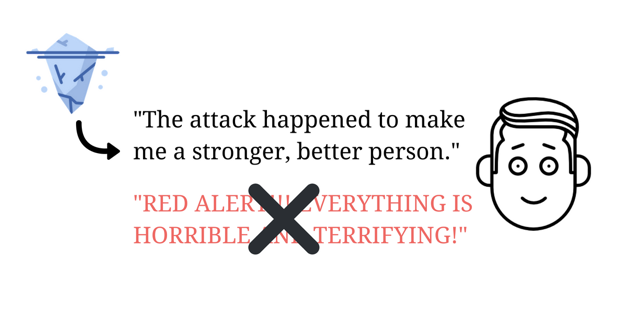
Notice that the Red Alert still isn’t gone — it’s just overwritten by a much more tolerable belief. The saber-toothed tiger attack has a comfortable place in your narrative as an obstacle you surmounted, and you have a strong, steady base to move on with your life … or do you?
Remember the tip of the iceberg, your stickiest narratives? That’s where things get complicated.
As psychologist Daniel Kahneman, Ph.D., says, our brains are associative machines that crave simplicity — they will fight to make things fit within our narrative and our current understanding. Anything else burns precious calories and throws off our emotions. So, your brain creates narratives that reinforce and protect your Lenses.

Some of the narratives are deceptively simple. You start feelin’ yourself. And meanwhile, the initial Red Alert gets pushed further and further down until you even forget it’s there.
If you prefer to imagine the system visually, think of it as a castle:
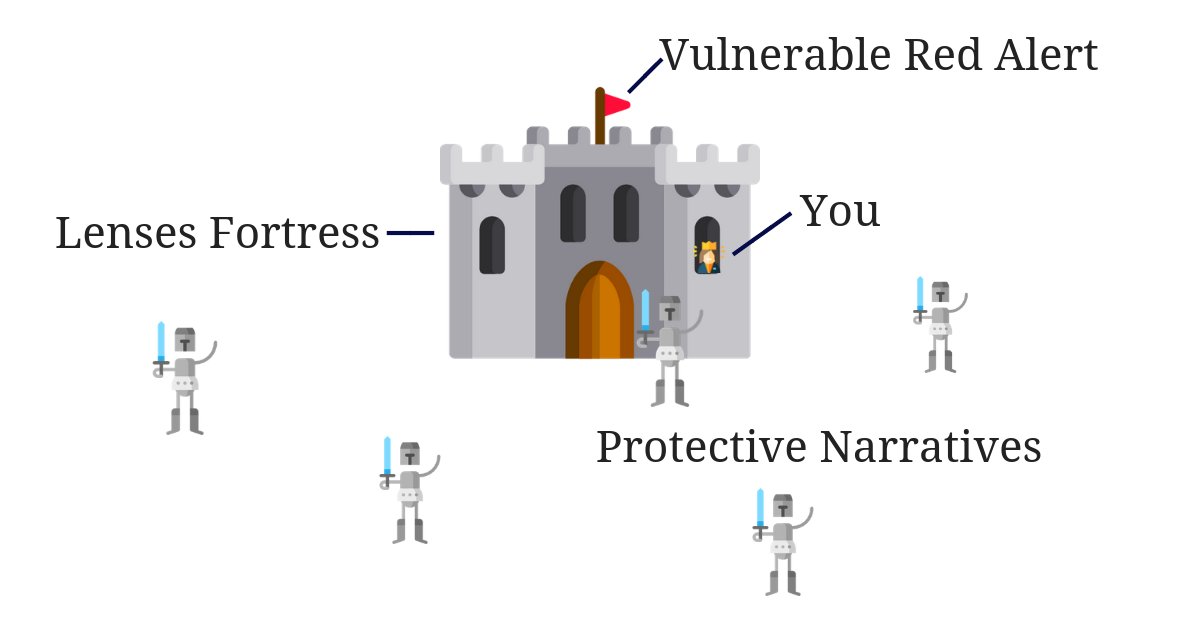
You, the ruling monarch, want to protect your vulnerable Red Alert. So, you’ve built a lovely Lenses Fortress to defend it.
When you sit inside your Lenses Fortress and stare out the window, everything looks great. You feel safe and secure. But this is a big world with lots of different kinds of threats, so you make some Protective Narratives reinforcements to be extra cautious.
The narratives are what actually roam around and interact with the world and keep threats from even reaching your front door.
Why does this matter? Saber-toothed tigers are extinct.
At this point, you may be wondering if every event that shifts your Lenses has to be some big, terrible trauma. The answer is no — but, as psychologist Judith Lewis Herman, M.D., says, the more uncomfortable the circumstance, the harder our brains will work to bury it.
We adopt Lenses that make our circumstance ideal, whether that’s the local religion, politics, feelings about the world, or overall way of life. Here’s a modern, non-saber-toothed-tiger example: Jane.
Jane is a manager of a local franchise. She took a job at the franchise right after college for some extra cash, never intending to stay. But one promotion led to another, one year turned into 20, and now, Jane makes decent money at a job she never really wanted.
At her core, she is deeply uncomfortable with her career path. She dreamed of being in a different field — one she got a degree for — but now she feels she’s too far down the road to change course.
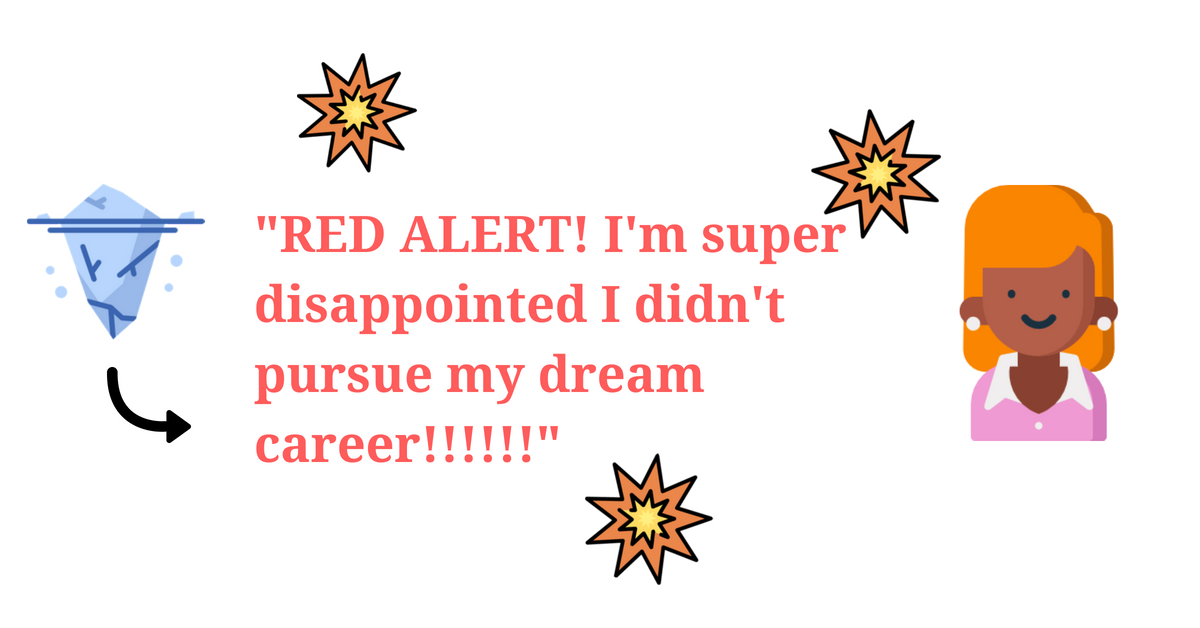
Like most people, Jane hates feeling icky or uncomfortable, and so her brain tries to ease her suffering. The problem is, she doesn’t believe changing careers is possible — she has children to support and a mortgage to pay, so she can’t afford to start at a lower level
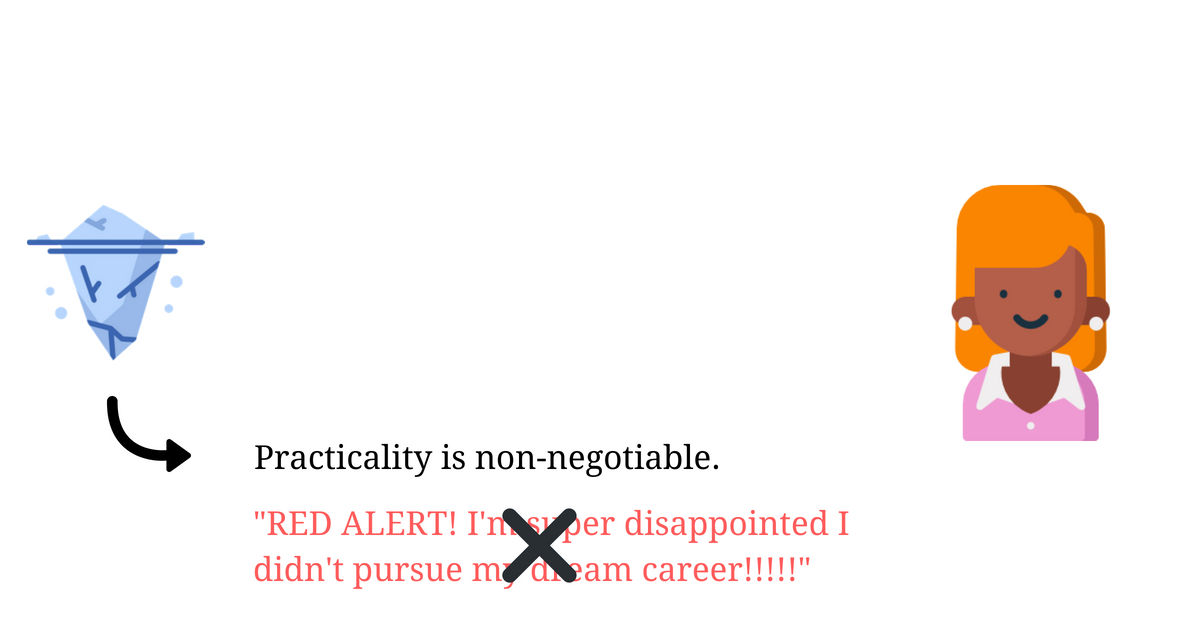
job. This reality feels awful. And so, instead, Jane’s Lenses shift so she can believe her situation is ideal.
Jane’s new Lenses, “Practicality is non-negotiable,” succeed in making her current career acceptable. But it would be even more helpful if the opposite was undesirable. So, her associative machine kicks in and forms the narratives “Dream careers are fluffy fairy tales” and “pursuing new technology when our current technology works just fine is a waste of time.”
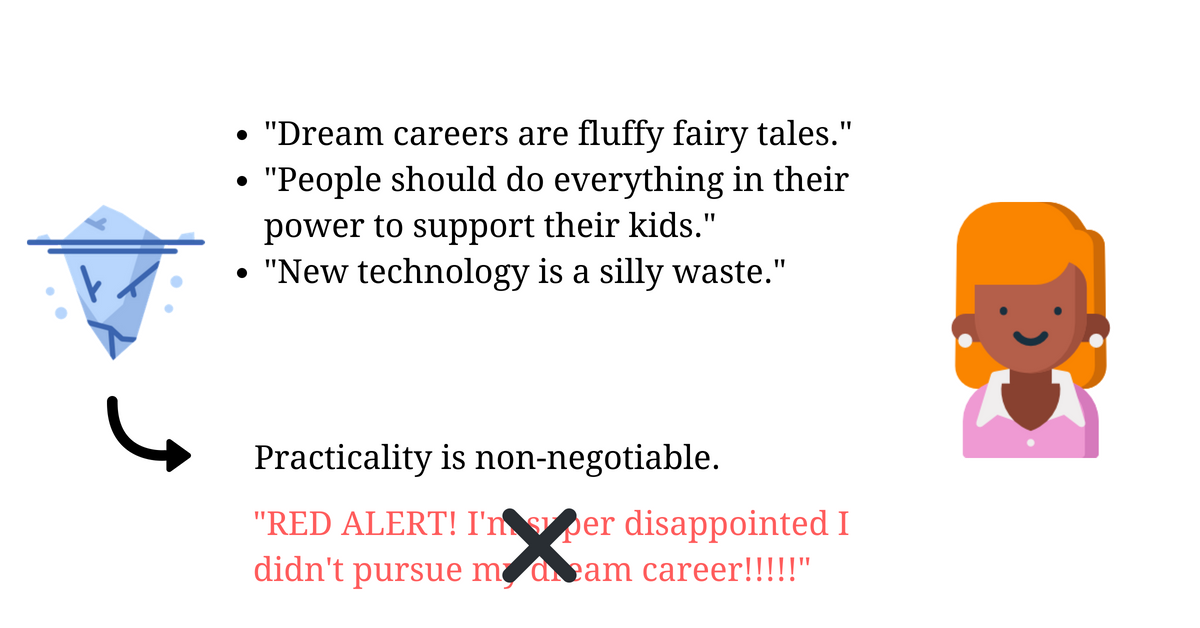
Why does this matter? Because Lenses like these are the blight of a massive company you may know. But more on that in part 2.
ACTION STEPS
ACTION STEP 1: We learn more about our Lenses by uncovering our stickiest, most stubborn narratives. To figure out what Lenses you’re wearing, think about what “triggers” you.
For example, if a friend says, “Hm, I think your pasta needs more salt,” and you immediately feel the wrath of a thousand suns come over you, try to stop and ask yourself why you’re having such a disproportionate reaction. What does “your pasta needing more salt” mean to you? What is it connected to?
Often, there’s a narrative lying just beneath the surface. Maybe it’s something like, “Good people are self-sustaining.” You interpret the person who is critiquing your cooking as insulting your ability to be self-sustaining.
Once you find the narrative, interrogate it even more. Ask yourself, “What do I gain by believing this?” Why would you want to believe “Good people are self-sustaining”?
Maybe your Red Alert was that you had a turbulent childhood home where you had to become independent at a really early age. So, you adopted the Lenses “Adversity made me stronger and more independent.” Got deep pretty quick there, didn’t we?
Try to identify one narrative you have that’s shaped by your Lenses.
ACTION STEP 2: Identifying other people’s Lenses is more complicated. Usually, you realize Lenses are distorting reality because someone you’re interacting with is behaving irrationally — and that’s not typically the best time to say, “Why is this affecting you so much?”
In this case, it’ll be harder to discover their sticky narrative since you aren’t in their head. Still, you can try to listen to the exact words they use to defend themselves. What specifically are they refuting?
For example, imagine you were the person who said, “Hm, I think your pasta needs more salt” and suddenly your friend flipped. In their response, they may drop hints to what’s actually going on: “My pasta is fine! What do you think, that I don’t know how to make pasta? That I can’t cook for myself? Fine, next time, you cook!”
In this case, the person flipping out hinted at their acting narrative when they defended their ability to cook for themselves.
Once you have this information, you can ask: “What do they gain by believing this?”
Part 2: What happens when Lenses and businesses clash?
Let’s go back inside the mind of Jane, the franchise manager who we called the blight of a major company. As a reminder, this is the overview of the Lenses and narratives her brain built:
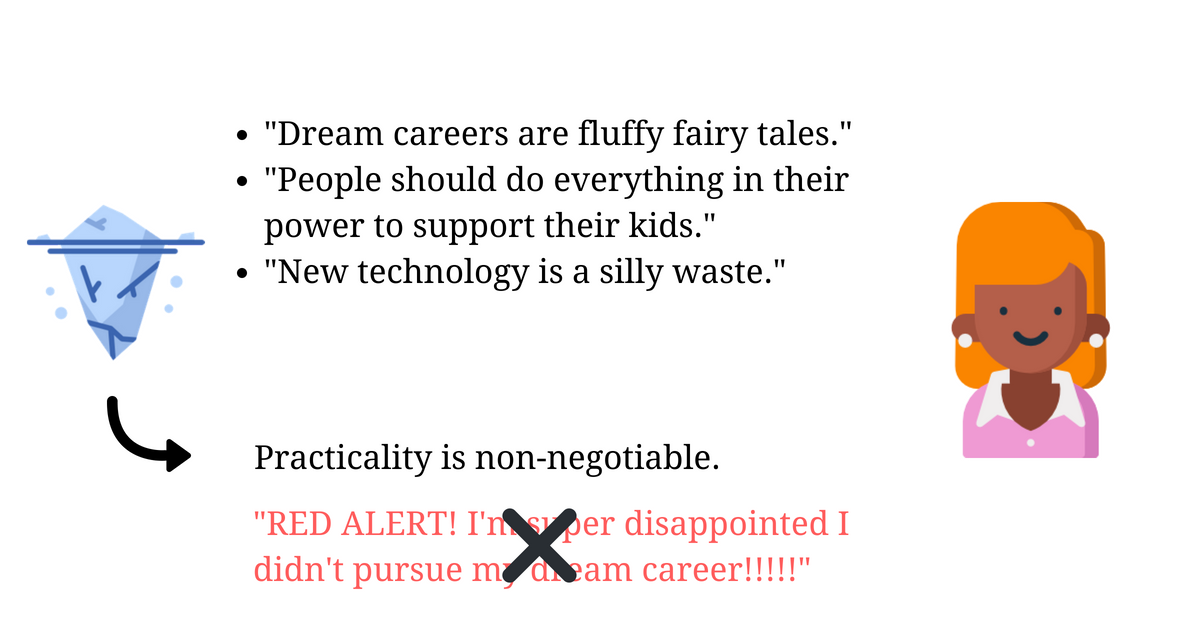
So, who does Jane’s brain matter to?
Apple.
Over the past decade, Apple has slowly but steadily been pushing the average consumer away from laptops and towards tablets. In fact, one of their 2017 ads was titled “What is a computer?” It’s ice cold. Check it out here:
The idea is that, unless you are a professional who needs a ton of processing power — an engineer, video editor, music producer, etc. — all of your needs can be reasonably met by a tablet.
They’re cheaper and lighter, and apparently, the only reason laptops have a hinge in the first place is because, at the time, we couldn’t make a screen small enough to put the components behind it.

It seems natural, then, that once the tech is good enough, most people will use a single-surface tablet instead of a laptop with a hinge. So, let’s imagine Thanksgiving 2010 at Jane’s house. Jane’s niece brings up how Apple is going to replace the laptop with tablets because most people don’t really need laptops.
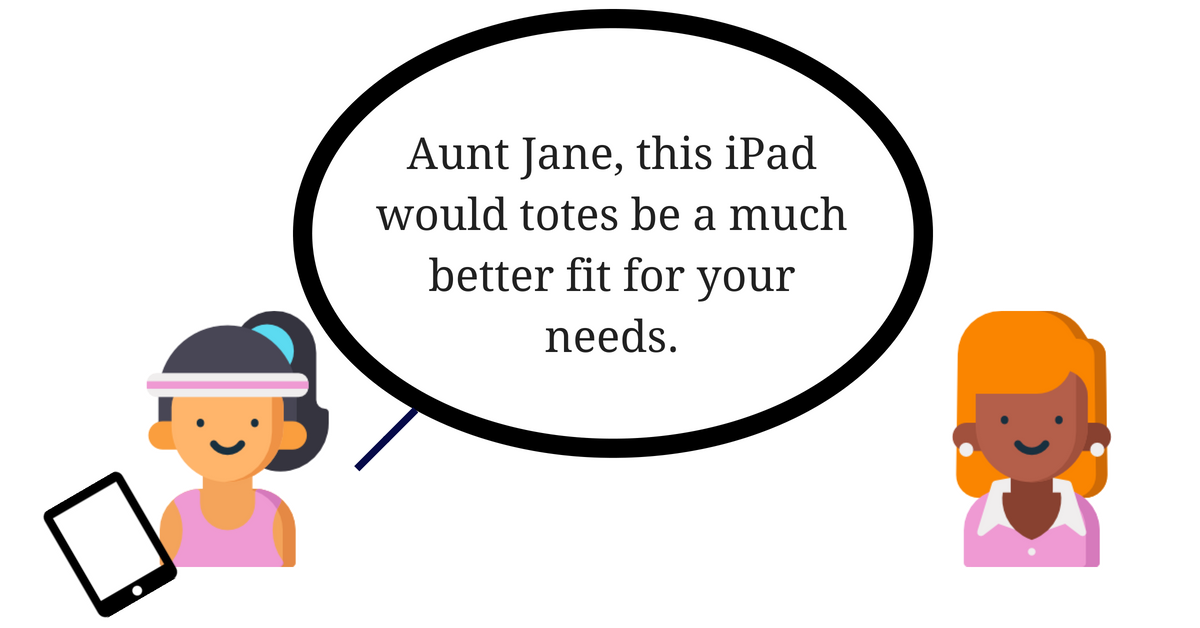
Interesting! Seems reasonable, right? So … will Aunt Jane trade in her old clunky laptop?
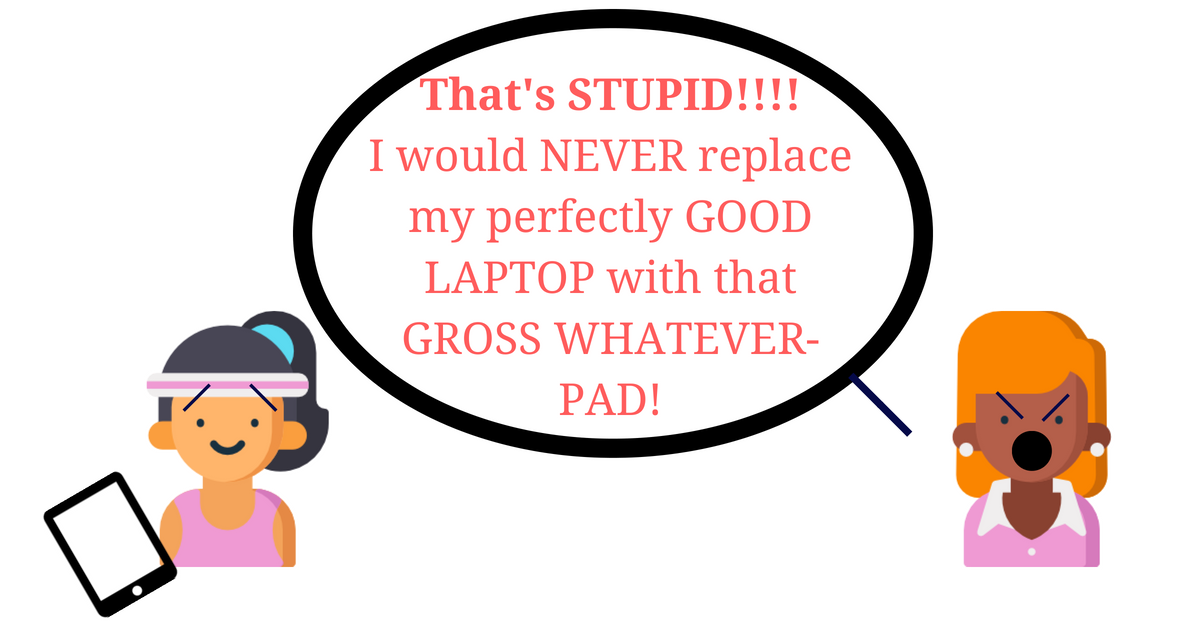
Woooooah! What happened there? What’d Aunt Jane flip out for??
On the surface, the iPad is a fantastic product for Jane. A tablet would actually be a better fit for Jane’s needs, as she only really uses her laptop for Excel, Netflix, and email. So, why did she have this visceral, over-the-top reaction?
Because Jane’s niece’s iPad pitch just fire-blasted one of her protective narratives.


The iPad contradicts her narrative, “New technology is a silly waste.” Her internal alarm system immediately went off to defend her against the threatening information. Her pulse quickened, and her hairs stood on end as her body went into fight-or-flight mode.
Why? Cognitive dissonance.
Cognitive dissonance is the psychological cost of your brain holding two contradictory beliefs at once. It feels icky and uncomfortable, so your brain chooses to either accept the new information and throw out the original narrative … or perceive the new information as a threat and reject it all together.
Another eloquent way of thinking about this is what Mark Manson calls “Manson’s Law of Avoidance” in his New York Times best-seller, The Subtle Art of Not Giving a F*ck: The more something threatens your identity, the more you will avoid it.
(Fun fact: In the novel 1984 by George Orwell, “doublethink” is the word used to describe when someone is actually able to hold two contradictory beliefs at once.)
This particular narrative, “New technology is a silly waste” — one that sounds so superficial and childish — is connected to something super fundamental to Jane’s identity: her Lenses.
Those Lenses represent the only line of defense between Jane and her Red Alert: the terrible, scary feelings about her unsatisfactory career. Would Jane really threaten her safety and comfort to open her mind to her niece’s dumb iPad pitch?

No. Of course not. And it’s understandable — Jane’s defensive reaction is based on biology.
In a study done by Jonas Kaplan at the University of Southern California’s Brain and Creativity Institute, researchers monitored the brain activity of test subjects as they watched a politically charged video.
Because the test subjects were told to pay attention, the part of their brain that controls critical thinking lit up. But the moment that the test subject noticed that the video was arguing against one of their deeply held political beliefs, the part of their brain that perceives threats turned on instead. (You can check out another fascinating recent study at New York University here.)
To explain what happened in the terms we’ve been using, likely, the test subjects’ political beliefs are related to the narratives that reinforce their Lenses. When their political belief narrative got fire-blasted, the alarms sounded, and the supreme monarch in their castle was too preoccupied to listen to the video anymore.
And that’s exactly what happened with the iPad.
To explain a bit more about what’s going on in this specific example, Robert Perez — an expert in manufacturing and distribution analysis — points out in this article that laptops have historically been a status symbol. In the early days of computers, the higher-ups at companies were given laptops, and so having a laptop broadcasted that you were important.
Even though today, laptops aren’t restricted to CEO-types, the narrative remains: a laptop means you do important work and nearly everyone likes to believe their work is important.
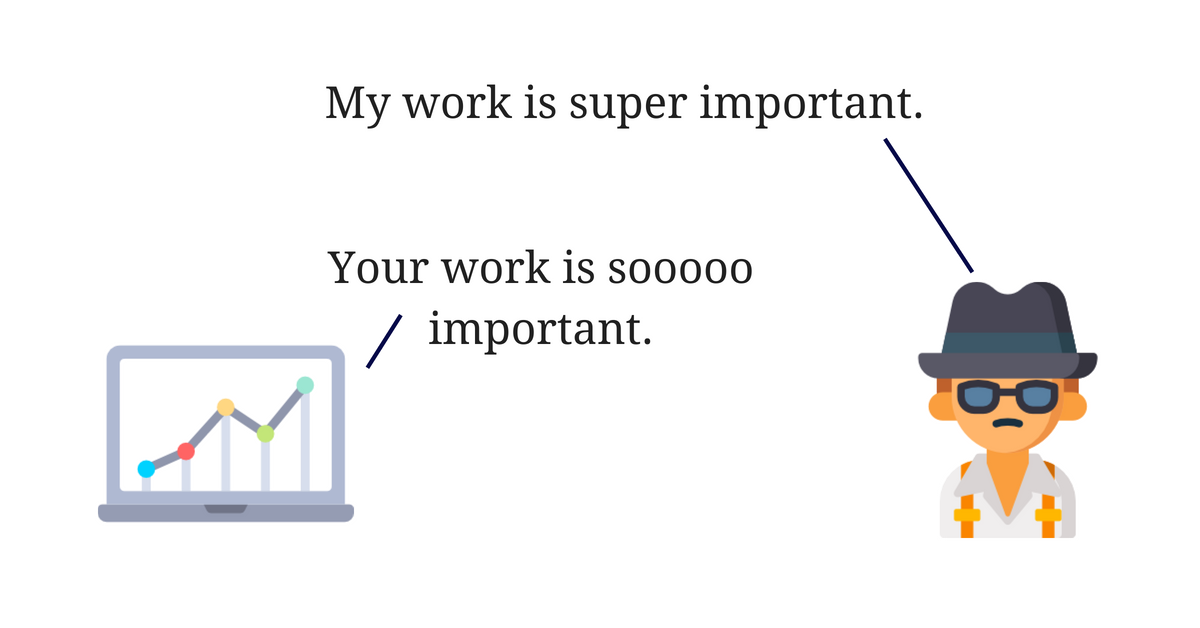
So, when the iPad first launched in 2010, haters had a lot to say. InfoWorld said it would “fail big time.” Fox News Online said that clearly “Apple lost its mojo.” Business Insider called it “a big yawn.” Bloomberg said they’d never hit their estimated sales goals.
From insisting that it was a product for old people who weren’t tech savvy enough to use real computers to maturely quipping that it sounded like a feminine hygiene product, people loved coming out of the woodwork to tell Steve Jobs what a piece of garbage he’d created.
Why? Because Apple’s marketing in the beginning focused on innovation and being different and high-tech. Check out the first-ever iPad commercial, which premiered during the 82nd Annual Academy Awards in 2010:
Back then, they were hammering home that tablets are lighter, faster, cooler, more innovative, cheaper, more powerful, and more advanced than anything else. It was exciting and fresh and new!
. . . And made many people hunker down to protect their vulnerable Lenses.
Apple’s messaging works for people who, as Simon Sinek said, want to be first. But for Apple to win over a huge percentage of people and have the iPad be adopted on a massive scale, they eventually needed to find a way to present it in a non-threatening way.
As an entrepreneur, you do not want your marketing, communication, or product to sound your target audience’s internal alarms.
You offer a valuable solution to your audience, and you know that it will be mutually beneficial if they purchase. But to make that happen, it’s important to remember that your audience’s understanding of their problem is shaded by their Lenses.
Once you know your audience’s brain better than they do, you can craft the perfect message to compel them to action.
Wish you could connect with more amazing people, and not feel awkward in social situations? Download our FREE Ultimate Guide To Social Skills below.
ACTION STEPS
In psychologist Drew Boyd’s Inside the Box, Boyd describes how in the 1950s, Betty Crocker’s cake mix only required adding water. The product was aimed at making the average American housewife’s life easier and less complicated — and people loved the cake! But sales were going down. Why?
General Mills (Betty Crocker’s parent company) hired a team of psychologists to figure out what was going on. It turns out, the average American housewife felt guilty for “deceiving” her guests with what she considered a non-homemade item. In other words, the ease of the cake mix set off the housewives’ Red Alert.
Your Action Step is to take on the role of General Mills’ psychologists: discover what narratives your offering or marketing may bump up against, and what Lenses lie beneath the surface.
To accomplish this, you can break down how your target audience talks about the problem you solve. If you already have clients, see if you can chat with them for a few minutes and get them to describe — in their own words — what they hope your product will do for them.
For example, if you sell shoes, ask your latest few customers what the perfect shoe would mean in their life. You may be expecting them to say, “I’d feel like I was walking on a cloud” when really their answer is something closer to, “I’d be the coolest kid in class.”
If you don’t have clients yet, you can ask a similar question (hypothetically) to people who you believe are in your target audience. For example, check out this awesome post about using Reddit for customer research and be sure to ask how their life would improve if they got the perfect product.
While it’s not logistically possible to understand each of your client’s unique Lenses, you will likely find a few recurring themes that can help guide the way you promote what you do.
Part 3: How can you use Lenses to your advantage?
How is Apple appealing to people like Jane today? Take a peek at their current sales page for iPads: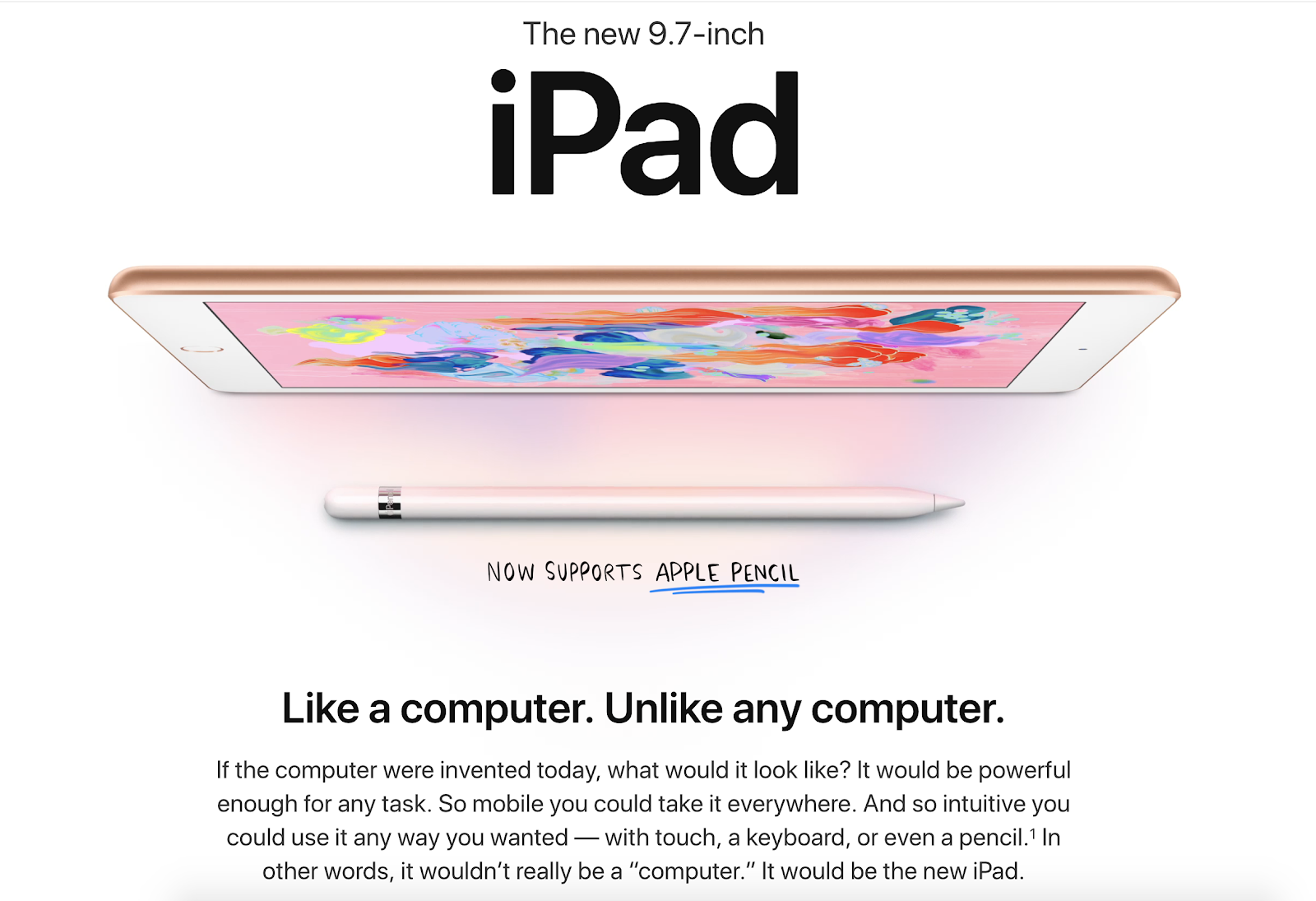
In this copy, Apple directly addresses the people who are afraid to give up their laptop by marketing the iPad as today’s computer. It’s not completely new. It’s an evolution of something comfortable and familiar. It lets Jane leave her protective Lenses intact while replacing her laptop with a practical, present-day computer … a tablet.
Is this marketing working? Based on the fact that their sales of the latest mass-market iPad have gone up, it’s safe to assume it is.
Let’s look at another example of using Lenses to boost sales: Weight Watchers. If you’re unfamiliar or fuzzy on what they do, basically, they offer an eating plan, branded foods, and a support group for people trying to lose weight. Here’s an ad from 1988 (buckle up, it’s a bumpy ride):
Ignoring the high cringe factor, the main benefit that these old commercials push is that their good-tasting diet food is a convenient way to lose weight. Clearly, Weight Watchers had a lot of success with this for quite some time. It’s possible their clients’ Lenses looked something like this:

Instead of violating one of these narratives, the 1988 commercial gave the audience something to help: the woman in the commercial acknowledged how sinful rich desserts usually are and then offered an alternative. Their audiences’ Lenses were okay with accepting a restrictive diet, so it was a great match.
But then, time passed, culture shifted, and Lenses changed.
Today’s wave of would-be Weight Watchers is influenced by things like the body positivity movement, advances in nutrition, dislike of yo-yo dieting, our ever-evolving understanding of the human body, and eating disorder awareness. Today, more people gravitate away from things that restrict what they can eat or do.
The average Lenses for Weight Watchers’ target audience may now look more like this:
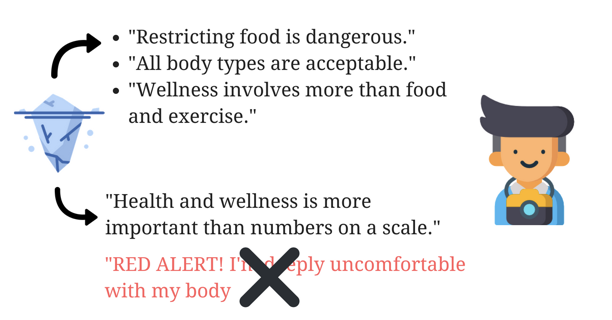
Notice the Red Alert is exactly the same, but the Lenses shifted to align with today’s trends.
The old Weight Watchers product and communication style is fundamentally incompatible with their audience’s new way of seeing the world. Even if people want to lose weight deep down, “losing weight” is not the problem they’re looking to solve — heck, they aren’t even comfortable admitting that goal to themselves.
You can’t convince someone they have a problem they aren’t ready to recognize — and therefore you can’t sell them the solution.
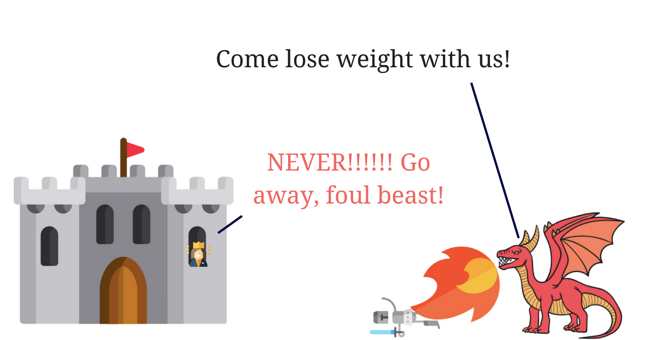
It’s unsurprising, then, that Weight Watchers’ outdated and restrictive approach to dieting hurt their sales. In the graph below (from the article “Why Weight Watchers is Losing So Much Money for Investors”), you can see the short-lived “Oprah bump” in late 2015.
…But there are somethings even Oprah can’t fix.
That could have been the end of Weight Watchers. The ship was sinking. People just didn’t want what Weight Watchers was a-cookin’.
But then, a superstar figured out how to flip the switch and work with their target audience’s Lenses instead of against them.
To become relevant again, CEO Mindy Grossman intelligently rebranded Weight Watchers as a “wellness company” (something pretty difficult to do, considering their name is “Weight Watchers”), and in 2018, they launched Weight Watchers Freestyle — a much less restrictive version of the plan.
Here’s some copy from their website now:
And a recent commercial:
Not only does this message not threaten any narratives, but it also helps to reinforce what their audience already believes. Since our brains are absolutely in love with confirmation bias — or seeking information that confirms what we already believe — Weight Watchers has crafted the perfect storm. And their numbers show it.
Here’s a snapshot of their stock over the last five years:
Ready to improve your habits and level up your life? Download our FREE Ultimate Guide To Habits below.
Putting Lenses to work: Three models
The key takeaway so far is that you can’t just kick in your audience’s door, copy a-blazin’, and try to change their stickiest narratives. It just won’t happen.
If you follow the Weight Watchers model, you can change your marketing to fit your target audience’s Lenses. All it takes is a) figuring out what the most common Lenses are right now and b) making sure your copy addresses a problem your audience actually thinks they have.
But there’s rarely just one way to do things. So let’s talk Burberry and McDonald’s.
The Burberry Model
In the early 2000s, Burberry faced what many believed was a high-fashion death sentence: they became the clothing of choice for “the chavs” — which meant it became seen as British gangwear.
Burberry was an older British brand, and the Lenses for that audience were not cool with dressing in gangwear. It looked like the end was near for the famous brown and red plaid.
But then, Burberry pulled off a miracle. By riding the social media wave and building their reputation for a fresh audience through innovation and technology, they were able to target the Lenses of a younger generation instead. And so, they came back from the dead.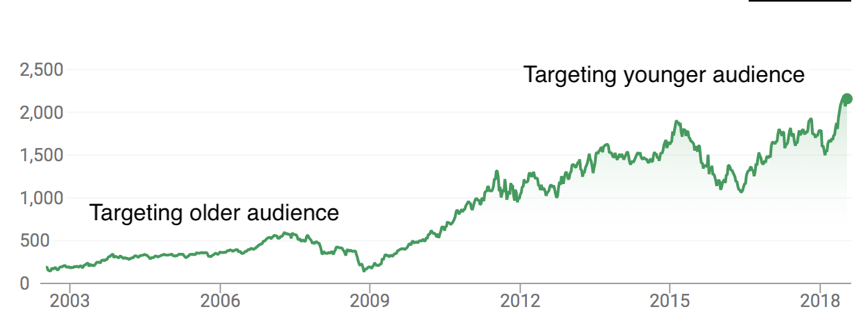
Steal Burberry’s model: if your product doesn’t align with your target audience’s Lenses, ask if that’s really your target audience. Maybe there’s a better niche for you.
The McDonald’s Model
I can’t remember a time when McDonald’s wasn’t a dominating fast food restaurant. But in the early 2000s, the company got hit with three years of misfortune that nearly sank it.
Right as civilization launched into the 21st century, McDonald’s was hit with year after year of bad press. In the beginning, they were called out by food critics and customers alike for their inconsistent, poor quality food. Their audience was caring more and more about their health, and the greasy options weren’t cutting it.
Then, in 2002, they tried to “go fancy” and put higher cost items on their menu, like adding a “Sandwich & Platter” and “Bakery & Ice Cream” section into their stores. It didn’t go too hot. Their audience didn’t want to pay more money for fancier food — especially when Burger King was offering such low prices.
And then, as a final kick, Morgan Spurlock ate only McDonald’s for a full month and then created his famous documentary, Super Size Me. Needless to say, Morgan got pretty sick, and McDonald’s had to figure something out.
Through their target audience’s Lenses, McDonald’s kept misfiring by attempting to solve the wrong problems. They weren’t in sync.
Instead of changing their marketing like Weight Watchers or their target audience like Burberry, McDonald’s knew they had to solve their problems at the roots: their product.
Over the next few years, McDonald’s standardized their meals across the franchises, introduced healthier meal options, and made their fleeting affair with the Value Menu a permanent engagement.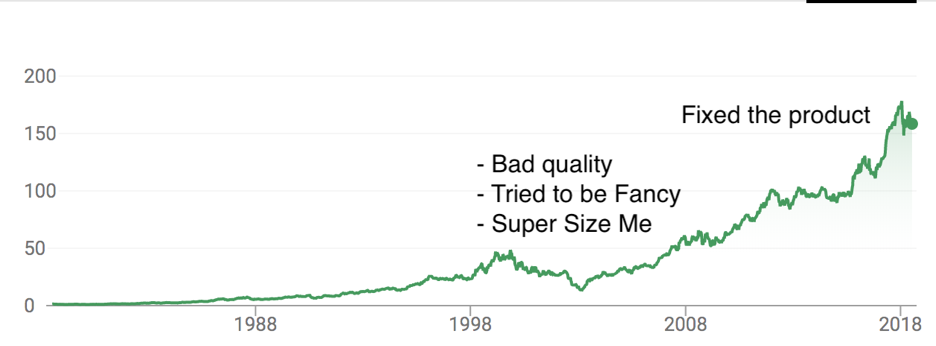
Steal the McDonald’s model: Make sure you are selling a product your audience actually wants. What your Lenses prioritize may not be the same as what your audience’s Lenses prioritize.
ACTION STEPS
In the previous Action Step, you identified your target audience’s most common narratives and probable Lenses. Now, evaluate if your marketing and/or product are violating them. If not, great! If they are, revisit the Weight Watchers, Burberry, and McDonald’s models to see if one may fit your situation:
- Weight Watchers: Change the marketing
- Burberry: Change the audience
- McDonald’s: Change the product
When 1950s housewives rejected Betty Crocker’s magic “just add water” cake mix, how did General Mills respond? How could they make their innovative product fit within the landscape of their target customers’ world?
By following the McDonald’s model and making the product more complicated.
The psychologists figured out that if housewives had to add water and an egg to the mix, they felt more ownership over the final result — they’d put in the effort and now they could call the cake homemade guilt-free. (It didn’t matter that the mix didn’t need an egg at all.) After that small tweak, sales boomed, and now, 70 years later, we all still know Betty Crocker’s name.
Part 4: Give your client what they want now . . . and what they need later
You are almost to the end of the Lenses road! Now, we’re going to talk about what happens when your target audience’s Lenses don’t align with why you feel you started this business in the first place.
When the iPad first came out in 2010, Apple’s marketing wasn’t focused on people like Jane — it was focused on innovation. Why? Because they were targeting the first 16% of the Innovation Adoption Curve: the Innovators and the Early Adopters.

That kind of marketing was effective then. But in 2018, Apple isn’t targeting the first 16% anymore. Now, they’re targeting the Majority — the middle 68% — and Apple knows that many people in the majority have reservations about giving up their laptop.
To snag them, Apple’s marketing needs to appeal to people like Jane without setting off their Red Alerts … like those initial 2010 ads would have.
So, their marketing strategy has necessarily changed since their first commercial in 2010. Now, they’re leaning into the familiar.
Playing the long game
Here’s the thing: it can be frustrating to communicate in a way that doesn’t align with your own personal Lenses.
I can only imagine that the folks on Apple’s marketing team already believe in (or at least appreciate) the benefits of the iPad and know that their innovative product could improve people’s lives.
Not being able to tell people this directly can feel like banging your head against the wall, but your truth only matters if your audience is willing to listen. Which is why we embrace the “Give them what they want now … and what they need later” philosophy.
Apple doesn’t need to give up on eventually showing Jane how innovative apps and accessories and editions of the iPad can enhance her life. But they do need to build trust first, and Apple can only do that if they secure Jane (and the 68% Majority) as customers.
Another prominent example of this “give them what they want then what they need” theory in action is Elon Musk: the serial entrepreneur behind PayPal, Tesla, SpaceX, Neuralink, the Hyperloop, SolarCity, and probably a bunch of other stuff I’m missing. Whether you love him, hate him, or don’t care at all, he’s a great example of an entrepreneur playing the long game.
On the (excellent) blog Wait But Why, Tim Urban wrote a monstrous collection of posts about everything Elon is hoping to accomplish and why it’s important.
Because it would take you hours to read all the articles (and I’d recommend it), I’ll give you the majorly abbreviated version: Elon Musk’s Lenses say, “The most important thing I could do with my life is ensure the survival of the human race.”
Honestly, I’m fascinated. But I can see how this may not mean much to people just going about their daily lives. The thing is, though, Elon eventually needs the support of many, many people to accomplish this monstrous goal — the 68%.
Every single one of his ventures is connected to these Lenses. Here is what his Lenses and some of his stickiest narratives may look like:
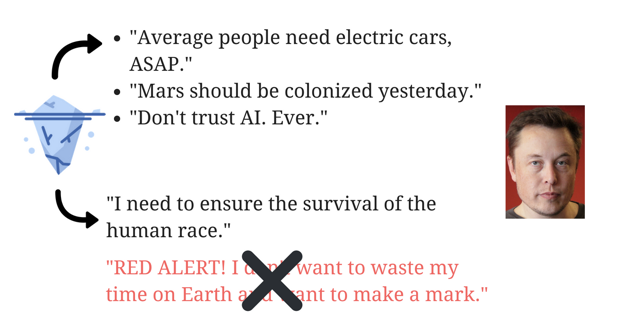
Each of his business ventures aligns with one of these sticky narratives. (As you can see in this example, sticky narratives can be scientific, as long as they massively impact the way you live your life.) Since Tesla is the business most likely to affect the average person first, let’s dive deeper into that.
More than 70% of the world’s carbon emissions come from transportation. So, getting everyone to switch over to electric cars would go a long freaking way towards slowing climate change down. That’s Elon’s goal with Tesla. And he’s not afraid to say so.
However, as you probably noticed, I just kicked the hornet’s nest: for quite a few people, acknowledging climate change as a man-made, critical problem violates a sticky narrative.
But if you scroll Elon’s Twitter feed, you’ll see he’s playing the long game.
Nine times out of 10, when Elon tweets or retweets about Tesla, it has nothing to do with greenhouse emissions or climate change — it’s about how great the car drives, how convenient it is to charge, how tough it is, how fast it goes, or other things that appeal to a much broader audience without triggering any sticky narratives.
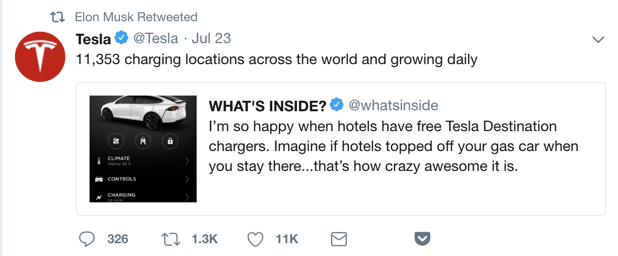



By putting his audience’s Lenses before his own, Elon can maintain communication with a broader audience. Then, one time out of 10, he can slip in a gentle nudge towards what he wants their Lenses to ultimately see: we should reduce carbon emissions.
ACTION STEPS
ACTION STEP: Try to separate your long game from what your audience wants right now. Are you trying to solve a problem they may not be ready to acknowledge?
If so, brainstorm how you can adjust your offering to accommodate their current status. One way you can do this is by breaking your offering into bite-sized pieces and giving your clients the ones that are easiest to swallow first.
Conclusion: Putting it all together
Over the course of this article, we explored what Lenses are and how they come into being, as well as how they connect with our stickiest narratives.
We took a peek at what happens when businesses and Lenses clash, and zoomed in on how some successful businesses have adjusted to fit their audience’s Lenses.
Then, finally, we placed satisfying your clients’ Lenses within the context of your entrepreneurial long game — or, how you can slowly shift your audience’s Lenses over time.
Being able to take a step back and consider someone’s Lenses is incredibly useful in business — but its applications don’t have to stop there.
Anytime you feel tension brewing while communicating with a vendor, friend, business partner, or family member, try to take a step back and see what may be going on beneath the surface. Odds are good there’s another way you could approach the same conversation with a little more consideration and earn much better results.
Ready to finally get that raise you deserve? We’ll walk you through everything you need to know (step-by-step) in our FREE Ultimate Guide to Getting A Raise. Just enter your email below:



